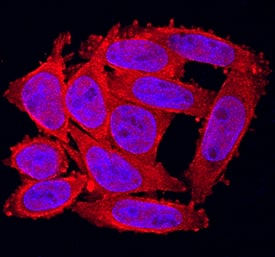Human FGF-20 Antibody
R&D Systems, part of Bio-Techne | Catalog # MAB2547

Key Product Details
Species Reactivity
Validated:
Cited:
Applications
Validated:
Cited:
Label
Antibody Source
Product Specifications
Immunogen
Met1-Thr211
Accession # Q9NP95
Specificity
Clonality
Host
Isotype
Scientific Data Images for Human FGF-20 Antibody
FGF‑20 in SW480 Human Cell Line.
FGF-20 was detected in immersion fixed SW480 human colorectal adenocarcinoma cell line using Rat Anti-Human FGF-20 Monoclonal Antibody (Catalog # MAB2547) at 10 µg/mL for 3 hours at room temperature. Cells were stained using the NorthernLights™ 557-conjugated Anti-Rat IgG Secondary Antibody (red; Catalog # NL013) and counterstained with DAPI (blue). Specific staining was localized to cytoplasm. View our protocol for Fluorescent ICC Staining of Cells on Coverslips.Applications for Human FGF-20 Antibody
Immunocytochemistry
Sample: Immersion fixed SW480 human colorectal adenocarcinoma cell line
Western Blot
Sample: Recombinant Human FGF-20 (Catalog # 2547-FG)
Reviewed Applications
Read 2 reviews rated 5 using MAB2547 in the following applications:
Formulation, Preparation, and Storage
Purification
Reconstitution
Formulation
Shipping
Stability & Storage
- 12 months from date of receipt, -20 to -70 °C as supplied.
- 1 month, 2 to 8 °C under sterile conditions after reconstitution.
- 6 months, -20 to -70 °C under sterile conditions after reconstitution.
Background: FGF-20
Fibroblast growth factor 20 (FGF-20) is a member of the FGF gene family, which currently contains 22 members. Based on its structure, it is further classified as an FGF-9 subfamily member. All FGF family members are heparin-binding growth factors with a 120 amino acid (aa) core FGF domain that exhibits a beta-trefoil structure (1). The cDNA of FGF-20 predicts a 211 aa polypeptide without a canonical signal peptide sequence, a feature shared with other members of this subfamily (2‑4). Nevertheless, it is secreted with a molecular weight of 27 kDa (2‑4). FGF-20 is known to bind to heparin (4). No alternate splice forms have been reported. However, three amino acid polymorphisms are known, and single nucleotide polymorphisms in noncoding regions that may effect expression show a strong correlation with a risk of developing Parkinson’s disease (5, 6). Human FGF-20 shows 98% aa identity to bovine FGF-20 and 95% aa identity to both rat and mouse FGF-20. Within the FGF-9 subfamily, FGF-20 is 69% and 63% aa identical to human FGF-9 and FGF-16, respectively. Human FGF-20 is reported to be promiscuous in its selection of receptors which include FGF R1c, FGF R2c, FGF R3b, FGF R3c and FGF R4 (4, 7, 8). FGF-20 is expressed a variety of cells, including dopaminergic neurons (2), fibroblasts, keratinocytes and breast epithelium (4), and multiple sites in the fetus (2, 7). Finally, the expression of FGF-20 and DKK-1 is regulated by beta-catenin during development and tumorigenesis, implying that FGF-20 may play a role in the oncogenesis induced by the Wnt signaling pathway (9).
References
- Itoh, N. and D.M. Ornitz (2004) Trends Genet. 20:563.
- Ohmachi, S. et al. (2000) Biochem. Biophys. Res. Commun. 277:355.
- Kirikoshi, H. et al. (2000) Biochem. Biophys. Res. Commun. 274:337.
- Jeffers, M. et al. (2001) Cancer Res. 61:3131.
- van der Walt, J. et al. (2004) Am. J. Hum. Genet. 74:1121.
- Genbank Accession # Q9NP95.
- Lavine, K.J. et al. (2005) Dev. Cell 8:85.
- Ohmachi, S. et al. (2003) J. Neurosci. Res. 72:436.
- Chamorro, M.N. et al. (2005) EMBO J. 24:73.
Long Name
Alternate Names
Entrez Gene IDs
Gene Symbol
UniProt
Additional FGF-20 Products
Product Documents for Human FGF-20 Antibody
Product Specific Notices for Human FGF-20 Antibody
For research use only
